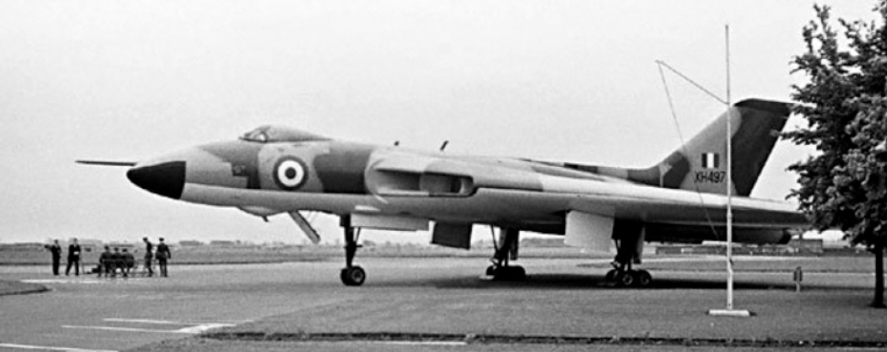SERVICE GRAVE
DENNIS GEORGE BLACKWELL (grave 82)
FLIGHT LIEUTENANT (NAVIGATOR PLOTTER)
617 SQUADRON
MY STORY
Died: 3rd July 1958
Most accidents are a combination of seemingly unrelated events which conspire to bring about disaster. Each of the factors in an accident may not in themselves cause significant danger. But, when they happen together, the unfortunate set of coincidences can quickly lead to loss of life. Such was the case for Dennis Blackwell.
On the 2nd of July 1958, the ground-crew manoeuvring Vulcan B1 XH497 out of the hangar could have had no idea how an apparently minor incident would bring about the death of Flight Lieutenant Blackwell.
617 Squadron had received the Vulcan into service less than two months previously. As with all new aircraft types, both air and ground crews were learning how to handle the aircraft. On the day prior to the accident, ground crew were using a Matador aircraft tug to push XH497 out of the hangar. During a left hand turn, the nose wheel was pushed beyond its design limits and the pivot bracket was fractured.
It is assumed that this damage went unnoticed and when XH497 took-off on a routine training flight the next day, part of the nose wheel fell off. The pilot, Flight Lieutenant Graham Smeaton now faced a very unusual dilemma, was it safer for his crew to remain with the aircraft and risk the consequences of a high-speed crash landing or should they bale-out and use their parachutes. Wisely choosing to get advice from the ground, he contacted the Officer Commanding 617 Squadron, Wing Commander Douglas Bower. Bower advised him to continue circling Scampton whilst he himself sought further advice. After an hour, it was decided that the three-rear crew should bale out over Waddington, after which Smeaton and his co-pilot, Flying Officer Wood would attempt a crash landing at Scampton.
Dennis Blackwell and his colleagues abandoned the aircraft at 3000 feet over Waddington. It was later reported that they did so very calmly and with the utmost professionalism. Unfortunately, a small error in the way Blackwell’s parachute was rigged prevented it from opening correctly. One of the cords connecting the main parachute to the auxiliary had become fouled on the emergency oxygen supply. Dennis Blackwell was killed instantly when he struck the ground.
Ironically, Flight Lieutenant Smeaton was able to bring the Vulcan in for a near normal landing. Enough of the nose undercarriage survived to keep the aircraft’s nose off the ground, causing only minor damage. Repairs were started on the day of the incident and it was expected that they would take less than a month to complete.
The inquest was held at RAF Waddington and this was not without controversy. The Coroner, Mr Pattinson was less than pleased to hear that a parachute expert from Farnborough would not be attending the inquest, and he let his feelings on the matter be known, saying: “This inquiry is in danger of becoming farcical without this expert”.
On a more conciliatory note, Mr Pattinson also said: “Whatever the evidence that comes out, I don’t want anyone to blame themselves. If they are to be blamed by authority, that is a different matter, but they must not blame themselves – I do not wish anybody, pilot, packers or manufacturers, those who jumped – to blame themselves in anyway”.
Recording a verdict of death by misadventure, Mr Pattinson summed up by saying: “I am in rather a difficult position. Naturally I would like to have asked the expert from Farnborough a lot of questions”.
He also had the following remarks about the crew of XH497: “They were a brave lot. It must have been agonising for them, but these chaps were perfectly calm, ordered and disciplined. I really do not think I can lay blame at anybody’s door in this matter”.
It does seem that the coroner was not aware of a number of very pertinent facts. The mishandling of the aircraft on the day previous and the incorrectly packed parachute did not feature in the inquest. In those days, the RAF would have no desire to air its dirty laundry in public and perhaps the non-appearance of the parachute expert was a deliberate move to make sure any failings were not exposed.
Today, the RAF has a very different approach to such matters. The more thoroughly an accident is investigated and the more widely the lessons learnt are published, the greater the chance that it won’t be repeated.

XH497 once it had returned to service.
